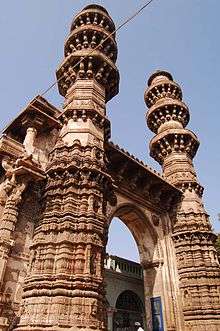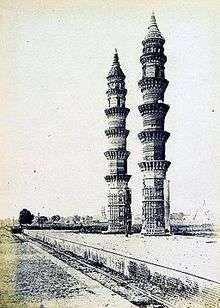Sidi Bashir Mosque
| Sidi Bashir masjid | |
|---|---|
 Shaking Minarets | |
 Location in Gujarat, India | |
| Basic information | |
| Location | Ahmedabad, India |
| Geographic coordinates | 23°01′40″N 72°36′04″E / 23.0276771°N 72.6011676°ECoordinates: 23°01′40″N 72°36′04″E / 23.0276771°N 72.6011676°E |
| Affiliation | Islam |
| Municipality | Ahmedabad Municipal Corporation |
| State | Gujarat |
| Status | Active |
| Architectural description | |
| Architectural type | Mosque |
| Completed | 1452 |
| Specifications | |
| Minaret(s) | 2 |
Sidi Bashir Mosque was located in the city of Ahmedabad, Gujarat. Due to its unique construction, the minarates of mosque are also called Jhulta Minar or Shaking Minarets.
History

It is believed that the mosque was constructed by Sidi Bashir, a slave of Sultan Ahmed Shah. A conflicting story is that the mosque was built by Malik Sarang, a noble in the court of Muhammed Begada, another Sultan of Gujarat. The mosque was completed in 1452.[1] Only the minarets and arched central gateway remain; the body of the building was destroyed in 1753 during the war between the Marathas and Khan of Gujarat Sultanate.[2]

On the north side, as the train enters the station, are the two tallest minarets in Ahmedabad. All traces of their mosque and the memory of its name and date are gone. The style and material of the minarets point to the close of Mahmud Begada's reign (1511), or perhaps rather later. Though much damaged, especially near the foot, the stairs inside the minarets may still be used.[2]An Englishman made an attempt to demolish one of the minarets of the mosque, but all in vain. He did so to unravel the mystery behind the swaying of minarets. The mechanism that leads to vibration is still a mystery. An interesting thing about Jhulta Minar is that, it can even withstand the pressure of fast moving trains that pass from a distance not lying very far from the minaret.This minar was built layer by layer that is why it can resist that much shaking without collapsing. Its around 600 years old.[3]
Minarets
There are two minarets in the mosque, each of which is three stories tall with carved balconies. A gentle shaking of either minaret results in the other minaret vibrating after a few seconds, though the connecting passage between them remains free of vibration. The actual cause of this is not yet known. This phenomenon was first observed in the 19th century by Monsier M. Williams, an English Sanskrit scholar.[4]
Other shaking minarets
Another mosque in Ahmedabad called the Raj Bibi mosque also had shaking minarets similar to the ones at the Sidi Bashir mosque. But the British dismantled one of the minarets in order to study the construction. The minaret could not be put back together.
There is also one in Isfahan, Iran called Monar Jonban (shaking minarets) with almost the same properties. There is one more, This is one of the largest mosques famous for its shaking minarets. The facade of this mosque is unique in details in addition to the three central archways wings are in shape of a triple arched formation having a doorway and side open windows with richly carved screens under them the minars are massive but elegant in appearance. Its lower parts are richly carved and its niches filled in with floral ornamentation of varied patterns. In the north end of the prayer hall is the Mulkhana or royal gallery enclosed by perforated screens. The Mosque was built by Makhdu-Ma-I-Jahan, mother of sultan Qutubuddin Ahmad Shah II in 1454 A.D.This royal lady lies buried in the mausoleum which is situated to the east of the mosque.
Present condition
The mosque is located opposite the Ahmedabad railway station and is one of the tourist destinations of Ahmedabad. Entry to the shaking minaret was prohibited following an incident at Qutb Minar in Delhi, where a stampede resulted in the deaths of many children. It is closed since last 15 years due to some damages to the upper sections of the minar. Both the minarets are connected. Another set of shaking minarets is present around 5 km from this, with one of the minarets from them being damaged.
References
| Wikimedia Commons has media related to Sidi Bashir Mosque. |
- ↑ "Sultanate Architecture". The Ahmedabad Chronicle: Imprints of a millennium. Vastu-Shilpa Foundation for Studies and Research in Environmental Design. 2002. p. 134.
- 1 2 Gazetteer of the Bombay Presidency: Ahmedabad. Government Central Press. 1879. p. 267.
- ↑ http://www.ahmedabad.org.uk/monuments/jhulta-minar.html
- ↑ "Siddi bashir mosque (shaking minarets)". All India Tour Travel Guide. Retrieved 2006-09-07.
- This article includes public domain text from Gazetteer of the Bombay Presidency: Ahmedabad. Government Central Press. 1879. p. 270.